

Compact Muon Solenoid
LHC, CERN
| CMS-SUS-15-011 ; CERN-EP-2016-132 | ||
| Search for new physics in final states with two opposite-sign, same-flavor leptons, jets, and missing transverse momentum in pp collisions at $\sqrt{s}= $ 13 TeV | ||
| CMS Collaboration | ||
| 4 July 2016 | ||
| J. High Energy Phys. 12 (2016) 013 | ||
| Abstract: A search is presented for physics beyond the standard model in final states with two opposite-sign, same-flavor leptons, jets, and missing transverse momentum. The data sample corresponds to an integrated luminosity of 2.3 fb$^{-1}$ of proton-proton collisions at $\sqrt{s}= $ 13 TeV collected with the CMS detector at the LHC in 2015. The analysis uses the invariant mass of the lepton pair, searching for a kinematic edge or a resonant-like excess compatible with the Z boson mass. Both search modes use several event categories in order to increase the sensitivity to new physics. These categories are based on the rapidity of the leptons, the multiplicity of jets and b jets, the scalar sum of jet transverse momenta, and missing transverse momentum. In addition, phase space regions are included for which excesses were reported using the $\sqrt{s}= $ 8 TeV data. A local significance of 2.6$\sigma$ for a kinematic edge search was observed by the CMS Collaboration, and of 3.0$\sigma$ for events compatible with the Z boson mass by the ATLAS Collaboration. The observations in all signal regions are consistent with the expectations from the standard model, and the results are interpreted in the context of simplified models of supersymmetry. | ||
| Links: e-print arXiv:1607.00915 [hep-ex] (PDF) ; CDS record ; inSPIRE record ; CADI line (restricted) ; | ||
| Figures | |

png pdf |
Figure 1:
Diagrams for gluino and $\tilde{ mathrm{ b } }$ pair production and decays realized in the simplified models. The GMSB model targeted by the on-Z search is shown on (a). On (b), the slepton-edge model features characteristic edges in the ${m_{\ell \ell }}$ spectrum given by the mass difference of the $\tilde{\chi}_2^0$ and $\tilde{\chi}^0_1$. |
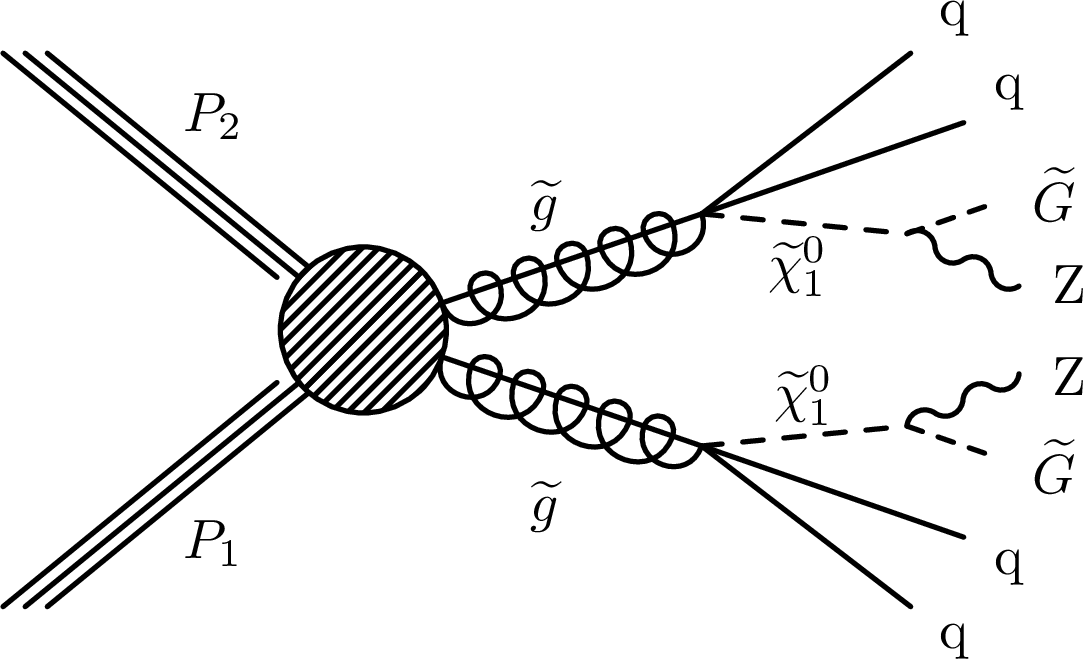
png pdf |
Figure 1-a:
Diagrams for gluino and $\tilde{ mathrm{ b } }$ pair production and decays realized in the simplified models. The GMSB model targeted by the on-Z search is shown on (a). On (b), the slepton-edge model features characteristic edges in the ${m_{\ell \ell }}$ spectrum given by the mass difference of the $\tilde{\chi}_2^0$ and $\tilde{\chi}^0_1$. |

png pdf |
Figure 1-b:
Diagrams for gluino and $\tilde{ mathrm{ b } }$ pair production and decays realized in the simplified models. The GMSB model targeted by the on-Z search is shown on (a). On (b), the slepton-edge model features characteristic edges in the ${m_{\ell \ell }}$ spectrum given by the mass difference of the $\tilde{\chi}_2^0$ and $\tilde{\chi}^0_1$. |
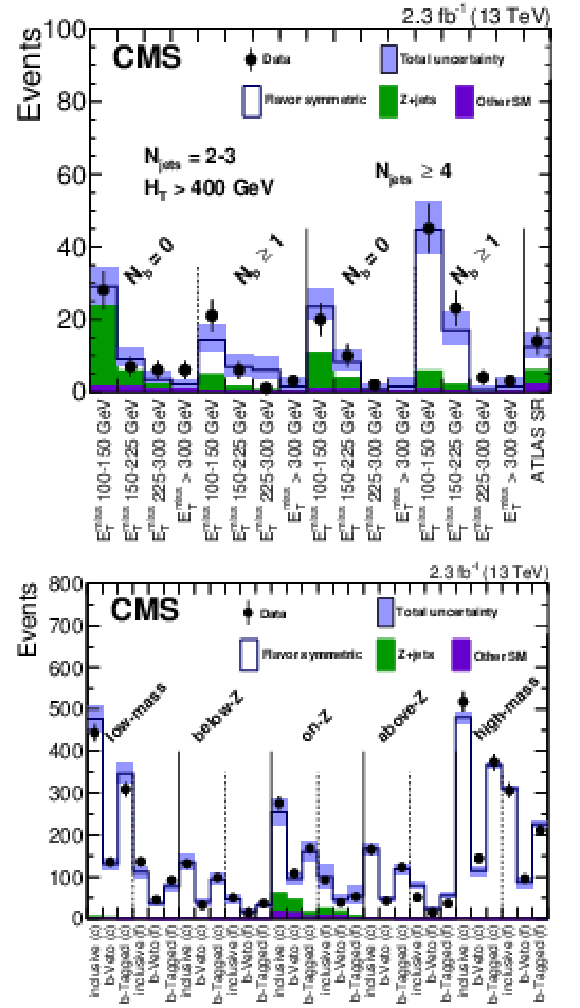
png pdf |
Figure 2:
Overview of the results in all signal regions of the on-Z search (a) and edge search (b). The labels (c) and (f) refer to central and forward leptons. The data points in black are compared to the background expectation, which is shown as a solid blue line, together with its uncertainty, shown as a light blue band. The background components are shown as a stacked histogram with solid white color for the FS background, solid dark green for DY and dark purple for others. |
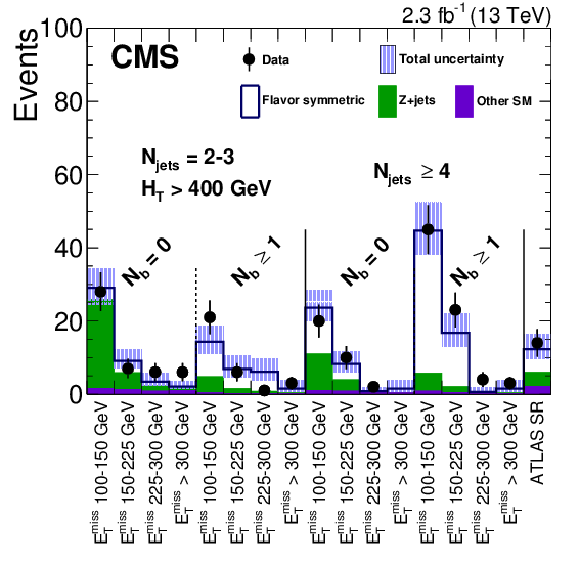
png pdf |
Figure 2-a:
Overview of the results in all signal regions of the on-Z search (a) and edge search (b). The labels (c) and (f) refer to central and forward leptons. The data points in black are compared to the background expectation, which is shown as a solid blue line, together with its uncertainty, shown as a light blue band. The background components are shown as a stacked histogram with solid white color for the FS background, solid dark green for DY and dark purple for others. |

png pdf |
Figure 2-b:
Overview of the results in all signal regions of the on-Z search (a) and edge search (b). The labels (c) and (f) refer to central and forward leptons. The data points in black are compared to the background expectation, which is shown as a solid blue line, together with its uncertainty, shown as a light blue band. The background components are shown as a stacked histogram with solid white color for the FS background, solid dark green for DY and dark purple for others. |

png pdf |
Figure 3:
The ${E_{\mathrm {T}}^{\text {miss}}} $ and ${m_{\ell \ell }}$ distributions are shown for data and background predictions in the on-Z ATLAS signal region (a) and for the region where CMS reported an excess in Run 1 (b). The ``Other SM'' category includes WZ, ZZ, and other rare SM backgrounds taken from MC. |
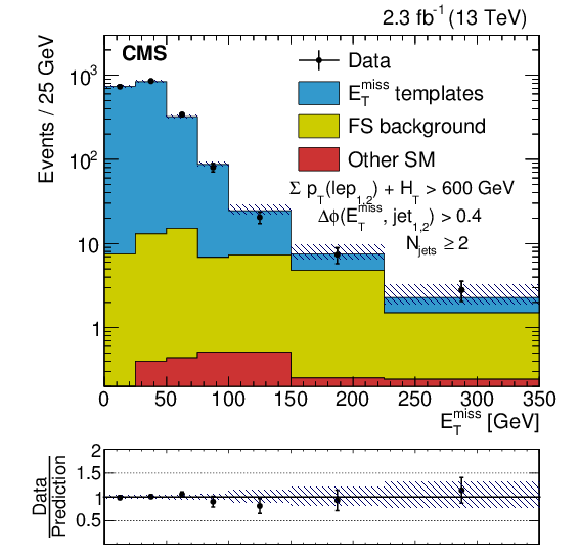
png pdf |
Figure 3-a:
The ${E_{\mathrm {T}}^{\text {miss}}} $ and ${m_{\ell \ell }}$ distributions are shown for data and background predictions in the on-Z ATLAS signal region (a) and for the region where CMS reported an excess in Run 1 (b). The ``Other SM'' category includes WZ, ZZ, and other rare SM backgrounds taken from MC. |

png pdf |
Figure 3-b:
The ${E_{\mathrm {T}}^{\text {miss}}} $ and ${m_{\ell \ell }}$ distributions are shown for data and background predictions in the on-Z ATLAS signal region (a) and for the region where CMS reported an excess in Run 1 (b). The ``Other SM'' category includes WZ, ZZ, and other rare SM backgrounds taken from MC. |

png pdf |
Figure 4:
Cross section upper limits and exclusions contours at 95% CL with the results of the on-Z search interpreted in the GMSB model. The region to the left of the red dotted (black solid) line shows the masses which are excluded by the expected (observed) limit. |
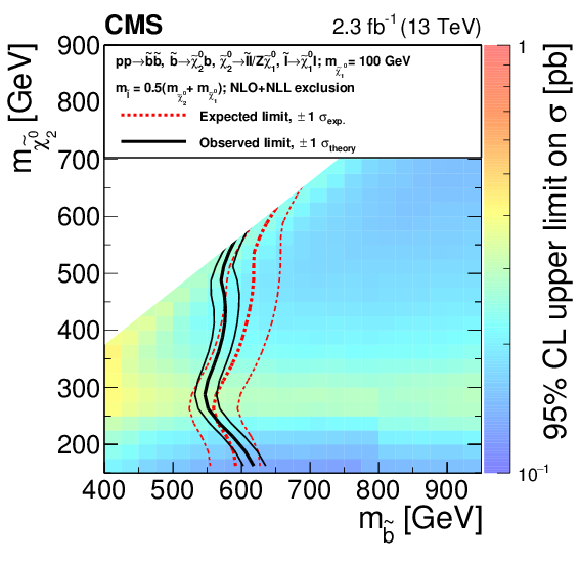
png pdf |
Figure 5:
Cross section upper limits and exclusion contours at 95% CL with the results of the edge search interpreted in the slepton-edge model. The region to the left of the red dotted (black solid) line shows the masses which are excluded by the expected (observed) limit. |
| Tables | |

png pdf |
Table 1:
Summary of $R_\mathrm {SF/OF}$ values obtained in data and simulation using the direct and factorized methods, and the final combination. |

png pdf |
Table 2:
Statistical uncertainties in the normalization of the ${E_{\mathrm {T}}^{\text {miss}}}$ template prediction in the $ {E_{\mathrm {T}}^{\text {miss}}} < $ 50 GeV range, for each signal region. These are taken as a systematic uncertainty in the background prediction. The definitions of SRA, SRB, and ATLAS SR are found in Section 5.1 and Table 4. |

png pdf |
Table 3:
Systematic uncertainties in percentage for the ${E_{\mathrm {T}}^{\text {miss}}} $ template method from the MC closure test, shown for all the on-Z signal regions. The definitions of SRA, SRB, and ATLAS SR are found in Section 5.1 and Table 4. |

png pdf |
Table 4:
Results for the on-Z search, binned as a function of ${H_{\mathrm {T}}} $, the jet multiplicity, the b jet multiplicity, and the missing transverse momentum. In the ATLAS SR an additional requirement is imposed on the angle between the ${E_{\mathrm {T}}^{\text {miss}}}$ and the two leading jets $\Delta \phi _{ {E_{\mathrm {T}}^{\text {miss}}},j_1,j_2} >$ 0.4. |

png pdf |
Table 5:
Results for the edge-like search in all 30 signal regions. The non-FS component of the total background is given separately in the brackets. All signal regions require ${E_{\mathrm {T}}^{\text {miss}}} >$ 150 (100) GeV if ${N_{\text {jets}}} \geq $ 2 (3). |
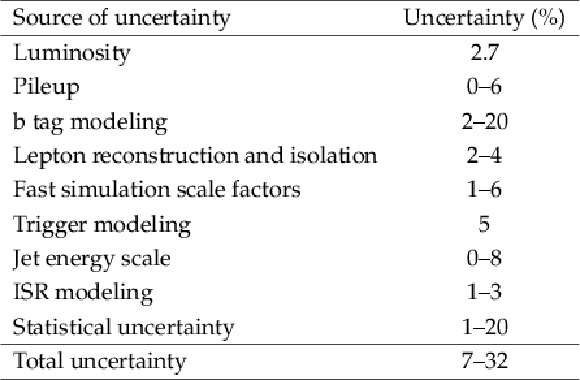
png pdf |
Table 6:
List of systematic uncertainties taken into account for the signal yields and typical values. |
| Summary |
|
A search for physics beyond the standard model has been presented in the opposite-sign, same-flavor lepton final state using a data sample of pp collisions collected at a center-of-mass energy of 13 TeV, corresponding to an integrated luminosity of 2.3 fb$^{-1}$, recorded with the CMS detector in 2015. Searches are performed for signals that either produce a kinematic edge, or a peak at the Z boson mass, in the dilepton invariant mass distribution. Comparing the observation to estimates for SM backgrounds obtained from data control samples, no statistically significant evidence for a signal has been observed. Notably, this is true for the two event selections where excesses of 2.6 and 3.0$\sigma$ significance had been observed by the CMS and ATLAS collaborations in their respective 8 TeV results. The search for events containing an on-shell Z boson is interpreted in a model of gauge-mediated supersymmetry breaking, where the Z bosons are produced in decay chains initiated through gluino pair production, and where the branching ratios have been fixed to 100% to produce the desired topology. Gluino masses below 1.28 TeV for high neutralino masses and 1.03 TeV for low neutralino masses have been excluded, extending the previous exclusion limits derived from a similar analysis at 8 TeV by almost 200 GeV. The search for an edge is interpreted in a simplified model based on bottom squark pair production, where dilepton mass edges are produced in decay chains containing the two lightest neutralinos and a slepton, where again the branching ratios have been fixed to produce the desired topology. Bottom squark masses below 550 and 620 GeV have been excluded, depending on the $\tilde{\chi}_2^0$ mass. These limits are similar to previous exclusion limits except for low $\tilde{\chi}_2^0$ masses where the excluded limits have been extended by about 100 GeV. |
| References | ||||
| 1 | P. Ramond | Dual theory for free fermions | PRD 3 (1971) 2415 | |
| 2 | Y. A. Gol'fand and E. P. Likhtman | Extension of the algebra of Poincar$ \'e $ group generators and violation of P invariance | JEPTL 13 (1971)323 | |
| 3 | A. Neveu and J. H. Schwarz | Factorizable dual model of pions | NPB 31 (1971) 86 | |
| 4 | D. V. Volkov and V. P. Akulov | Possible universal neutrino interaction | JEPTL 16 (1972)438 | |
| 5 | J. Wess and B. Zumino | A Lagrangian model invariant under supergauge transformations | PLB 49 (1974) 52 | |
| 6 | J. Wess and B. Zumino | Supergauge transformations in four dimensions | NPB 70 (1974) 39 | |
| 7 | P. Fayet | Supergauge invariant extension of the Higgs mechanism and a model for the electron and its neutrino | NPB 90 (1975) 104 | |
| 8 | H. P. Nilles | Supersymmetry, supergravity and particle physics | Phys. Rep. 110 (1984) 1 | |
| 9 | G. R. Farrar and P. Fayet | Phenomenology of the Production, Decay, and Detection of New Hadronic States Associated with Supersymmetry | PLB 76 (1978) 575 | |
| 10 | I. Hinchliffe et al. | Precision SUSY measurements at CERN LHC | PRD 55 (1997) 5520 | hep-ph/9610544 |
| 11 | CMS Collaboration | Search for physics beyond the standard model in events with two leptons, jets, and missing transverse momentum in pp collisions at $ \sqrt{s} = $ 8 TeV | JHEP 04 (2015) 124 | CMS-SUS-14-014 1502.06031 |
| 12 | ATLAS Collaboration | Search for supersymmetry in events containing a same-flavour opposite-sign dilepton pair, jets, and large missing transverse momentum in $ \sqrt{s}= $ 8 TeV pp collisions with the ATLAS detector | EPJC 75 (2015) 318 | 1503.03290 |
| 13 | CMS Collaboration | The CMS experiment at the CERN LHC | JINST 3 (2008) S08004 | CMS-00-001 |
| 14 | CMS Collaboration | Performance of electron reconstruction and selection with the CMS detector in proton-proton collisions at $ \sqrt{s} = $ 8 TeV | JINST 10 (2015) P06005 | CMS-EGM-13-001 1502.02701 |
| 15 | CMS Collaboration | Particle--flow event reconstruction in CMS and performance for jets, taus, and $ E_{\mathrm{T}}^{\text{miss}} $ | CDS | |
| 16 | CMS Collaboration | Commissioning of the particle-flow event reconstruction with the first LHC collisions recorded in the CMS detector | CDS | |
| 17 | M. Cacciari, G. P. Salam, and G. Soyez | The anti-$ k_t $ jet clustering algorithm | JHEP 04 (2008) 063 | 0802.1189 |
| 18 | M. Cacciari, G. P. Salam, and G. Soyez | FastJet user manual | EPJC 72 (2012) 1896 | 1111.6097 |
| 19 | M. Cacciari and G. P. Salam | Dispelling the N$ ^3 $ myth for the $ k_t $ jet-finder | PLB 641 (2006) 57 | hep-ph/0512210 |
| 20 | CMS Collaboration | Determination of Jet Energy Calibration and Transverse Momentum Resolution in CMS | JINST 6 (2011) P11002 | CMS-JME-10-011 1107.4277 |
| 21 | M. Cacciari and G. P. Salam | Pileup subtraction using jet areas | PLB 659 (2008) 119 | 0707.1378 |
| 22 | CMS Collaboration | Identification of b quark jets at the CMS Experiment in the LHC Run 2 | CMS-PAS-BTV-15-001 | CMS-PAS-BTV-15-001 |
| 23 | J. Alwall et al. | The automated computation of tree-level and next-to-leading order differential cross sections, and their matching to parton shower simulations | JHEP 07 (2014) 079 | 1405.0301 |
| 24 | S. Alioli, P. Nason, C. Oleari, and E. Re | NLO single-top production matched with shower in POWHEG: $ s $- and $ t $-channel contributions | JHEP 09 (2009) 111 | 0907.4076 |
| 25 | E. Re | Single-top Wt-channel production matched with parton showers using the POWHEG method | EPJC 71 (2011) 1547 | 1009.2450 |
| 26 | R. Gavin, Y. Li, F. Petriello, and S. Quackenbush | FEWZ 2.0: A code for hadronic Z production at next-to-next-to-leading order | CPC 182 (2011) 2388 | 1011.3540 |
| 27 | R. Gavin, Y. Li, F. Petriello, and S. Quackenbush | W Physics at the LHC with FEWZ 2.1 | CPC 184 (2013) 208 | 1201.5896 |
| 28 | M. Czakon and A. Mitov | Top++: A Program for the Calculation of the Top-Pair Cross-Section at Hadron Colliders | CPC 185 (2014) 2930 | 1112.5675 |
| 29 | C. Borschensky et al. | Squark and gluino production cross sections in pp collisions at $ \sqrt{s} = $ 13, 14, 33 and 100 TeV | EPJC 74 (2014), no. 12 | 1407.5066 |
| 30 | S. Frixione, P. Nason, and C. Oleari | Matching NLO QCD computations with Parton Shower simulations: the POWHEG method | JHEP 11 (2007) 070 | 0709.2092 |
| 31 | T. Sjostrand, S. Mrenna, and P. Skands | A brief introduction to PYTHIA 8.1 | Comp. Phys. Comm. 178 (2008) 852 | 0710.3820 |
| 32 | NNPDF Collaboration | Parton distributions for the LHC Run II | JHEP 04 (2015) 040 | 1410.8849 |
| 33 | GEANT4 Collaboration | GEANT4 --- a simulation toolkit | NIMA 506 (2003) 250 | |
| 34 | S. Abdullin et al. | The fast simulation of the CMS detector at LHC | J. Phys. Conf. Ser. 331 (2011) 032049 | |
| 35 | S. P. Martin | A supersymmetry primer | in Perspectives on Supersymmetry II, G. L. Kane, ed Adv. Ser. Direct. High Energy Phys., vol. 21 (2010) 1 | hep-ph/9709356 |
| 36 | T. Junk | Confidence level computation for combining searches with small statistics | NIMA 434 (1999) 435 | hep-ex/9902006 |
| 37 | A. L. Read | Presentation of search results: the $ CL_s $ technique | JPG 28 (2002) 2693 | |
| 38 | ATLAS and CMS Collaborations | Procedure for the LHC Higgs boson search combination in summer 2011 | CMS-NOTE-2011-005 | |
| 39 | G. Cowan, K. Cranmer, E. Gross, and O. Vitells | Asymptotic formulae for likelihood-based tests of new physics | EPJC 71 (2011) 1554 | 1007.1727 |
| 40 | CMS Collaboration | CMS Luminosity Measurement for the 2015 Data Taking Period | CMS-PAS-LUM-15-001 | CMS-PAS-LUM-15-001 |

|
Compact Muon Solenoid LHC, CERN |

|

|

|

|

|

|